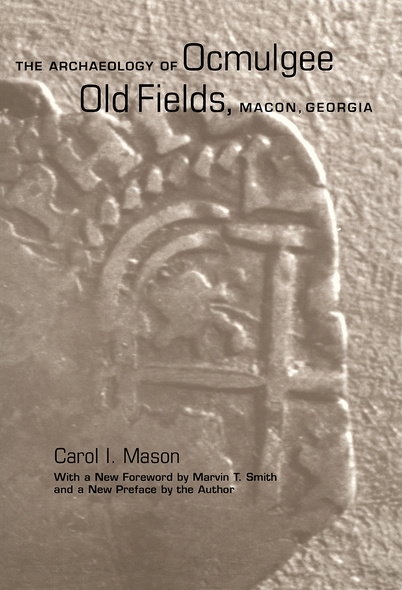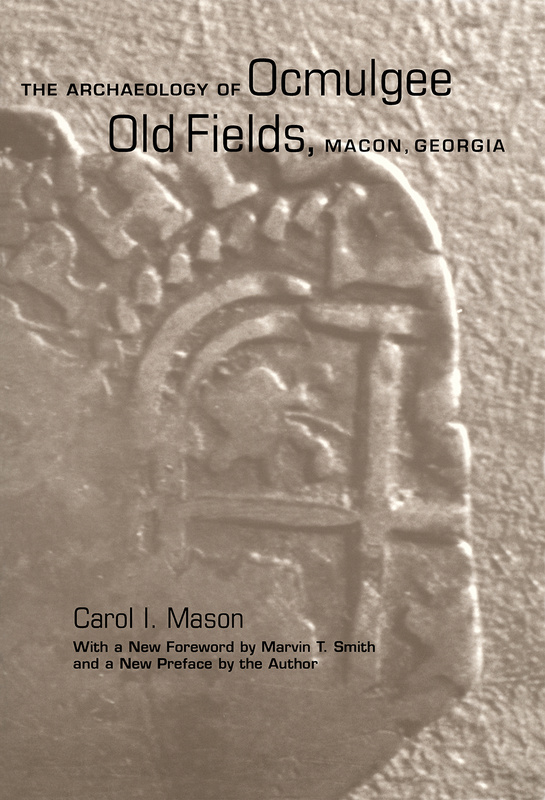The Archaeology of Ocmulgee Old Fields, Macon, Georgia
University of Alabama Press
A Dan Josselyn Memorial Publication
A 17th-century trading post and Indian town in central Georgia reveal evidence of culture contact and change
Ocmulgee Old Fields near Macon, Georgia, is the site of a Lower Creek village and associated English trading house dating from the late 17th and early 18th centuries. It was excavated in the early 1930s as part of a WPA project directed by A. R. Kelly, which focused primarily on the major Mississippian temple mounds of Macon Plateau. The specific data for the Old Fields was not analyzed until nearly 30 years after the excavation.
Part of the significance of this site lies in its secure identification with a known group of people and the linkage of those people with recognizable archaeological remains. The Old Fields site was among the very first for which this kind of identification was possible and stands at the head of a continuing tradition of historic sites archaeology in the Southeast.
Carol I. Mason's classic study of the Ocmulgee Old Fields site has been a model for contact-period Indian archaeology since the 1960s. The report includes a discussion of the historic setting and an analysis of the archaeological materials with an identification of the Lower Creek town and possibly of the English trader who lived there. Now, for the first time, the original report is widely available in book form. With a new foreword by the author and a new introduction from Southeastern archaeology expert Marvin T. Smith, readers have the benefit of a contemporary view of this very fine piece of careful scholarship.
A 17th-century trading post and Indian town in central Georgia reveal evidence of culture contact and change
Ocmulgee Old Fields near Macon, Georgia, is the site of a Lower Creek village and associated English trading house dating from the late 17th and early 18th centuries. It was excavated in the early 1930s as part of a WPA project directed by A. R. Kelly, which focused primarily on the major Mississippian temple mounds of Macon Plateau. The specific data for the Old Fields was not analyzed until nearly 30 years after the excavation.
Part of the significance of this site lies in its secure identification with a known group of people and the linkage of those people with recognizable archaeological remains. The Old Fields site was among the very first for which this kind of identification was possible and stands at the head of a continuing tradition of historic sites archaeology in the Southeast.
Carol I. Mason's classic study of the Ocmulgee Old Fields site has been a model for contact-period Indian archaeology since the 1960s. The report includes a discussion of the historic setting and an analysis of the archaeological materials with an identification of the Lower Creek town and possibly of the English trader who lived there. Now, for the first time, the original report is widely available in book form. With a new foreword by the author and a new introduction from Southeastern archaeology expert Marvin T. Smith, readers have the benefit of a contemporary view of this very fine piece of careful scholarship.
This volume is valuable as a landmark in Southeastern research.' —Southeastern Archaeology
‘Mason’s work presents the analysis and interpretation of a large body of material excavated by Works Progress Administration archaeologists during the 1930s and, in this case, continued into the 1940s. Large-scale projects, undertaken by field crews numbering in the hundreds of workers, amassed quantities of artifactual material and supporting documentation. In many instances, substantial amounts of material remain unanalyzed and unreported to this day. . . . The Ocmulgee Old Fields site with its mix of indigenous and European people, local material culture and trade goods, and varied functions represents an opportunity to study the Lower Creeks between 1670 and 1717. . . . I recommend (this volume) to all colleagues laboring to understand the early historic peiod in the Southeast.’ —The Florida Anthropologist
‘A masterful blend of meticulous archaeological analysis and wide-ranging historical research . . . with extraordinary style and wisdom.’
—Journal of Field Archaeology
A classic study of Contact period archaeology. . . . This volume examines the late 17th-early 18th century Creek village and fortified English trading post on the Macon Plateau. . . . An exemplary model for Contact archaeology studies today.’
—Journal of Middle Atlantic Archaeology
‘Mason’s work significantly advanced Creek archaeology in general and the archaeology of European-Indian contact studies in particular. She combined excellent historical research with archaeological analysis, yielding a historical archaeological synthesis that was groundbreaking for the emerging discipline of historical archaeology. . . . Her description of the European trading post and analysis of aboriginal features intruding this European feature are extremely detailed. She was able to document Native use of the trading post area by the Creeks after the post was abandoned.’
—from the new Foreword by Marvin T. Smith
Carol I. Mason is professor of anthropology at Lawrence University in Appleton, Wisconsin, and author of Wisconsin Indians: Prehistory to Statehood.
Contents
List of Plates, Tables, and Figures
Foreword by Marvin T. Smith
Preface
Original 1963 Preface
Introduction 1
1. The Historical Setting
Part I. Archaeological Evidence
2. Excavations at Ocmulgee
3. The Trading House
4. The Lower Creek Town Site
5. Artifacts
Plates
Part II. Historical and Archaeological Implications
6. Identification of the Creek Town
7. The Lower Creeks and Their Neighbors
8. The Origins of Lower Creek Ceramics
9. Conclusions
Appendix I. Catalogue Numbers of Illustrated Artifacts
Appendix II. Pottery Types
References Cited
Index





